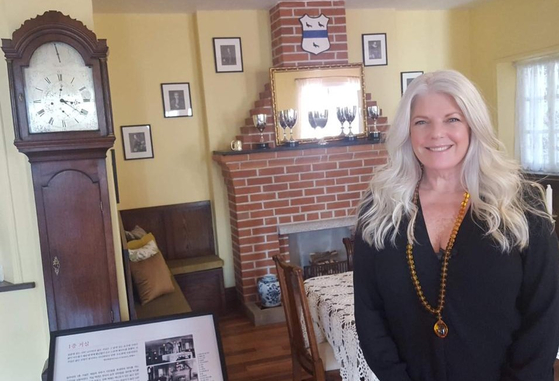
Jennifer Taylor, granddaughter of Albert and Mary Taylor, who built Dilkusha. The amber necklace on his neck is a replica of his grandmother’s artifact he donated this time. Photographed and provided by Robert Neff, photographer and historical researcher
Jennifer Taylor, born and raised in California, USA, liked to hear from her father about the country of Korea across the Pacific Ocean. He has never been there, but when he talks about Seoul, the city where his grandfather and grandmother lived with affection, he said his father’s eyes sparkled exceptionally. Jennifer’s grandparents are Albert and Mary Taylor. Albert Taylor was an American reporter from the Associated Press who reported to the New York Times (NYT) on March 13, 1919 about the March 1 independence movement that took place in various parts of Korea. Father Bruce Taylor was born in Severance Hospital in Seoul.
Jennifer, a descendant of Taylor who reported on the March 1st Movement
“I hope you remember the Americans who helped Korean independence”
Donation of 1,000 artifacts to’Dilkusha’
![The old appearance of Dilkusha, Albert Taylor's house. [중앙포토]](https://i0.wp.com/pds.joins.com/news/component/htmlphoto_mmdata/202103/01/787ef25f-c543-4085-83fc-a16cf8ad7c87.jpg?w=560&ssl=1)
The old appearance of Dilkusha, Albert Taylor’s house. [중앙포토]
Jennifer Taylor visited Seoul ahead of the 102nd anniversary of the March 1st Movement. Due to the pandemic, they were also quarantined for two weeks. This is to commemorate the house that grandparents built and lived in Seoul in the 1920s and named it’Dilkusha’. ‘Dilkusha’, which means’Palace of Joy’ in Sanskrit, has been renovated as a memorial to honor the Taylors’ will. From the 1st, it is possible for ordinary citizens to see it through advance reservation. Jennifer donated the relics related to Dilkusha left by her grandparents and became the first contributor to this reopening. He said in an interview with the JoongAng Ilbo on the 27th, “There were artifacts left by my grandparents everywhere in the house, and I thought that it would be more meaningful to display them in Korean Dilkusha.” .

A relic of Dilkusha, which will be open to the public from March 1st. Viewing is only possible by online reservation. Photo Seoul
Jennifer also donated the relics left by her grandmother with great heart. It is an amber necklace he loved. The city of Seoul, who had reopened, presented him with a replica of the same design as a sign of gratitude.
Why is the name’Dilkusha’? Jennifer shared her family history.
“My grandfather and grandmother met in Yokohama (Japan), and later lived in India. At that time, they saw a beautiful palace called’Dilkusha’ and thought,’If we build a house later, we should name it Dilkusha.’ . It is a small house in the middle of Seoul, but for grandparents it was a’palace of joy’ as the name implies.”
Albert Taylor. The March 1 Movement was announced to the world through the New York Times.

Although Dilkusha was completed in 1924, it was burned down by lightning strikes. Jennifer’s grandfather, however, did not give in and rebuilt the building in 1930. However, in the eyes of Japanese imperialism, Albert was blind, and eventually he and his family were expelled from Joseon. It was in 2006 that Albert’s son and Jennifer’s father, Bruce, came back to Dilkusha in Seoul. It is said that Jennifer also accompanied him for the first time. Jennifer said, “I wasn’t familiar with my feet for some reason,” and said, “I am desperate to hope that this place will be able to convey the breath of history not only to Koreans but also foreigners visiting Korea.” Father Bruce died in 2015. Jennifer said, “Before the reopening, my father would have wanted to donate all the artifacts to Dilkusha.”

The’Dilkusha’ exhibition hall is open to the public from March 1st. Photo Seoul
Jennifer said that she would also participate in the March 1st ceremony to be held on the morning of the 1st at the request of the government. He said, “I think I will be reading some of the Declaration of Independence in English.” His grandfather Albert was able to write about the March 1st Movement to NYT thanks to the acquisition of the Declaration of Independence. This is more meaningful to Jennifer. When I asked if there was anything I wanted to leave to him, the answer came back.
“If Koreans remember that in the long past, there was an American who worked hard for the independence of Joseon, I would like nothing more. That’s all.”
Reporter Jeon Sujin [email protected]
![]()
